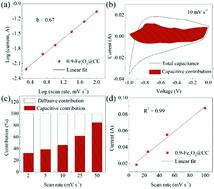当前位置:
X-MOL 学术
›
Mater. Chem. Front.
›
论文详情
Our official English website, www.x-mol.net, welcomes your
feedback! (Note: you will need to create a separate account there.)
Rapid synthesis of high-areal-capacitance ultrathin hexagon Fe2O3 nanoplates on carbon cloth via a versatile molten salt method
Materials Chemistry Frontiers ( IF 6.0 ) Pub Date : 2020-07-22 , DOI: 10.1039/d0qm00410c Yi-Jie Gu 1, 2, 3, 4 , Wei Wen 1, 2, 3, 4, 5 , Shilie Zheng 2, 3, 4, 6 , Jin-Ming Wu 1, 2, 3, 4
Materials Chemistry Frontiers ( IF 6.0 ) Pub Date : 2020-07-22 , DOI: 10.1039/d0qm00410c Yi-Jie Gu 1, 2, 3, 4 , Wei Wen 1, 2, 3, 4, 5 , Shilie Zheng 2, 3, 4, 6 , Jin-Ming Wu 1, 2, 3, 4
Affiliation

|
Earth abundant and environmentally benign iron oxides are ideal candidates for electrochemical energy storage. We report herein a rapid (within 1 min), facile one-step molten salt method to homogeneously coat various metal oxides of Fe2O3, Mn3O4, Co3O4, NiO, CuO, ZnO, etc. on carbon cloth (CC) for supercapacitor applications. In particular, ultra-thin Fe2O3 nanoplates coated on CC (Fe2O3@CC) connected in series to form a porous structure. Nanoplates have a larger specific surface area and hence more active sites for electrochemical reactions and the porous architecture effectively relieves the volume expansion of Fe2O3 during charging/discharging, which avoids the structural collapse and benefits the cycling stability. As a result, the Fe2O3@CC exhibits a large areal capacitance of 4175.7 mF cm−2 at a scan rate of 2 mV s−1 in −1.0–0 V vs. Hg/HgO, thanks also to the carbon cloth substrate activated simultaneously by the molten salt. The Fe2O3@CC electrode is especially appropriate for high current density (over 10 mA cm−2) charging/discharging. A Mn3O4@CC positive electrode is also synthesised via the molten salt method, and then coupled with the Fe2O3@CC negative electrode to assemble a 2 V high-voltage asymmetric supercapacitor (ASC) in 6 M KOH aqueous electrolyte. The Mn3O4@CC//Fe2O3@CC ASC delivers a high energy density of 2.91 mW h cm−3 at a power density of 25 mW cm−3 and a high power density of 278 mW cm−3 with a corresponding energy density of 1.25 mW h cm−3. An excellent cycling performance of 96% capacitance retention after 10 000 cycles at a high current density of 10 mA cm−2 is also recorded. The facile, versatile synthetic method and resultant high-performance electrodes are promising for practical applications in flexible electrochemical energy storage.
中文翻译:

通用熔融盐法在碳布上快速合成高面积电容超薄六角形Fe2O3纳米板
富含地球和对环境无害的氧化铁是电化学储能的理想选择。我们在此报告了一种快速(1分钟以内),简便的一步熔盐方法,以在碳上均匀地涂覆Fe 2 O 3,Mn 3 O 4,Co 3 O 4,NiO,CuO,ZnO等各种金属氧化物超级电容器应用的布(CC)。特别是涂在CC(Fe 2 O 3上的超薄Fe 2 O 3纳米板@CC)串联连接以形成多孔结构。纳米板具有更大的比表面积,因此具有更多的电化学反应活性位点,并且多孔结构有效地缓解了充放电过程中Fe 2 O 3的体积膨胀,避免了结构塌陷并有益于循环稳定性。结果,Fe 2 O 3 @CC在相对于Hg / HgO的-1.0-0 V中,在2 mV s -1的扫描速率下具有4175.7 mF cm -2的大面积电容。底物同时被熔融盐活化。铁2 O 3@CC电极特别适合于高电流密度(超过10 mA cm -2)的充电/放电。还通过熔融盐法合成了Mn 3 O 4 @CC正极,然后将其与Fe 2 O 3 @CC负极耦合以在6 M KOH水性电解质中组装2 V高压非对称超级电容器(ASC) 。Mn 3 O 4 @ CC // Fe 2 O 3 @CC ASC在25 mW cm -3的功率密度和278 mW cm -3的高功率密度下提供2.91 mW h cm -3的高能量密度。相应的能量密度为1.25 mW h cm -3。还记录了在10 mA cm -2的高电流密度下进行10 000次循环后96%电容保持率的出色循环性能。简便,通用的合成方法以及由此产生的高性能电极有望在挠性电化学储能中实际应用。
更新日期:2020-08-27
中文翻译:

通用熔融盐法在碳布上快速合成高面积电容超薄六角形Fe2O3纳米板
富含地球和对环境无害的氧化铁是电化学储能的理想选择。我们在此报告了一种快速(1分钟以内),简便的一步熔盐方法,以在碳上均匀地涂覆Fe 2 O 3,Mn 3 O 4,Co 3 O 4,NiO,CuO,ZnO等各种金属氧化物超级电容器应用的布(CC)。特别是涂在CC(Fe 2 O 3上的超薄Fe 2 O 3纳米板@CC)串联连接以形成多孔结构。纳米板具有更大的比表面积,因此具有更多的电化学反应活性位点,并且多孔结构有效地缓解了充放电过程中Fe 2 O 3的体积膨胀,避免了结构塌陷并有益于循环稳定性。结果,Fe 2 O 3 @CC在相对于Hg / HgO的-1.0-0 V中,在2 mV s -1的扫描速率下具有4175.7 mF cm -2的大面积电容。底物同时被熔融盐活化。铁2 O 3@CC电极特别适合于高电流密度(超过10 mA cm -2)的充电/放电。还通过熔融盐法合成了Mn 3 O 4 @CC正极,然后将其与Fe 2 O 3 @CC负极耦合以在6 M KOH水性电解质中组装2 V高压非对称超级电容器(ASC) 。Mn 3 O 4 @ CC // Fe 2 O 3 @CC ASC在25 mW cm -3的功率密度和278 mW cm -3的高功率密度下提供2.91 mW h cm -3的高能量密度。相应的能量密度为1.25 mW h cm -3。还记录了在10 mA cm -2的高电流密度下进行10 000次循环后96%电容保持率的出色循环性能。简便,通用的合成方法以及由此产生的高性能电极有望在挠性电化学储能中实际应用。











































 京公网安备 11010802027423号
京公网安备 11010802027423号